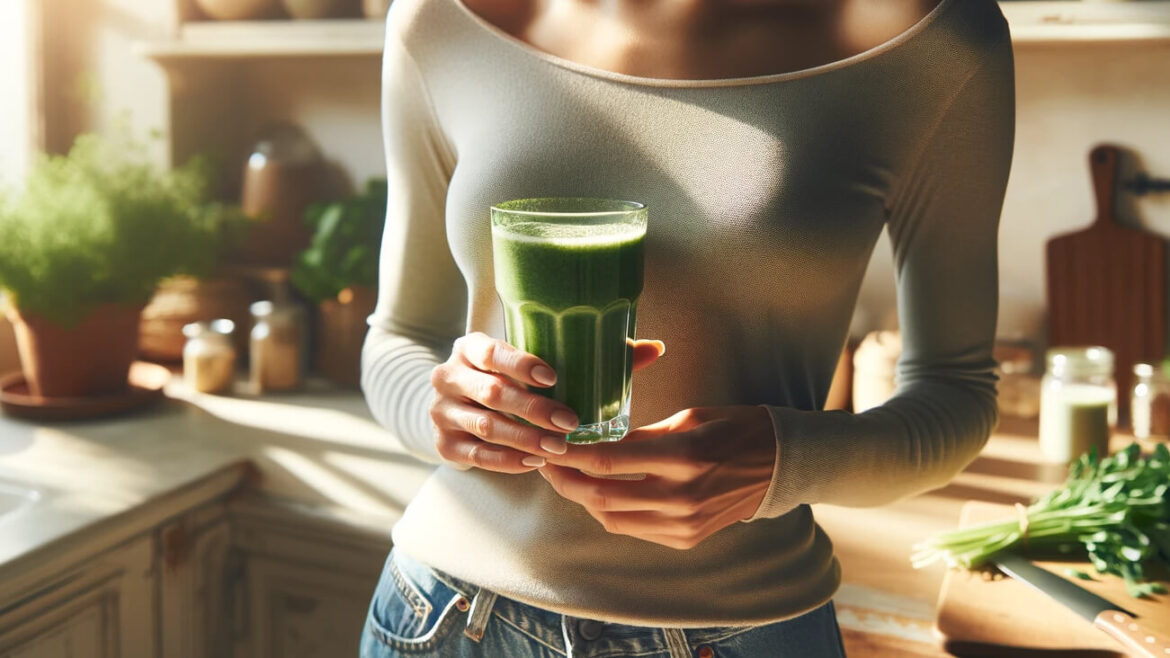The smoothie diet has become increasingly popular in recent years, and it's no wonder why – it's convenient, simple to follow, and produces noticeable results. If you haven't come across it before, you're in the right place. In this post, I'll introduce you to this diet and share the most effective ways to utilize it for weight loss and improved health.
What Is The Smoothie Diet?
The smoothie diet is a flexible eating plan where you substitute some or all of your regular meals with smoothies. Its main goal is to increase whole foods consumption, thus giving your body a break from processed foods. It helps you lose weight by reducing calories and giving your body the essential nutrients it needs to stay healthy.
Unlike some diets that completely cut out solid foods, the smoothie diet promotes a balance by allowing you to include healthy solid meals and snacks, too. That makes it a more sustainable and well-rounded approach to eating.
Health benefits of the smoothie diet
Whole foods make up the biggest part of the smoothie diet. They are the most nutrient-dense food you can consume, so following this diet brings many health benefits.
Here’s why it’s worth considering:
- Boost in nutrients: This diet is an easy way to ensure you get the rainbow of nutrients from whole foods. They are packed with vitamins, minerals, and antioxidants essential for optimal health.
- Good nutrient absorption: Since smoothies are blended, they can make it easier for your body to digest and absorb all the essential nutrients.
- Weight loss: Smoothies are great for portion control. They allow you to measure and consume precise amounts of ingredients, which helps control calorie intake and prevents overeating.
- Gut health: The fiber content in smoothies feeds your gut microbiome and helps to increase bowel movements, which is great for your overall health. Moreover, it lets you stay full longer and consume fewer calories, which is great if you're trying to lose weight.
- Health boost: Smoothie ingredients like turmeric can provide many health benefits. They contain nutrients that can boost the immune system, reduce inflammation, and cleanse the body.
- Sustainability: The smoothie diet isn't just about drinking smoothies. Having healthy, solid meals and snacks alongside them makes it more balanced and doable as a long-term eating habit.
Who should avoid the smoothie diet?
While the smoothie diet can be great for your health, it's important to recognize that it may not suit everyone. Some people should approach this diet with caution or avoid it entirely for the reasons below:
- Specific Health Issues: People with conditions like kidney disease may need to limit the consumption of certain ingredients high in potassium and phosphorus. Moreover, those with diabetes should be cautious due to the potential high sugar content in fruits.
- Digestive Issues: For people with conditions such as IBS, the high fiber content in smoothies can sometimes worsen symptoms.
- Pregnant or Breastfeeding: Women who are pregnant or breastfeeding should be careful. While smoothies can be a healthy addition to their diet, they should not replace meals with them. Reduced calorie intake from a smoothie-based diet might lead to low nutrient intake, which is critical for the health of both mom and baby.
- Certain Medications: Some ingredients commonly found in smoothies can interact with medications. For instance, vitamin K-rich greens can impact the efficacy of blood thinners.
- Allergy Concerns: Anyone allergic to common smoothie ingredients like certain fruits, nuts, or dairy should be careful and look for substitutes.
Although the smoothie diet can be a great kickstart to better health, it may only be ideal for some. With these considerations in mind, let's move on to the next part. I'll share the best smoothie diet strategies to help you lose weight and feel your best.
Starting The Smoothie Diet
One of the best things about the smoothie diet is its simplicity. Many people love it for this reason.
Here's how it works:
- Choose your health goal: This could be anything from improving your health (like boosting your immune system, helping your gut, or improving your skin) to losing weight or detoxing.
- Pick a plan: Based on your goal, choose a plan. Each plan will guide you on how many of your daily meals should be smoothies and how many should be regular, solid foods.
- Understand your calorie needs: Each plan suggests how many calories you should eat daily to reach your goal. Remember, these are just suggestions. You can change them to fit your body needs, daily activity level, and overall health.
- Tailor it to you: Use an online calculator to determine your daily calorie needs. It helps you figure out how much you should eat and drink, making sure your smoothies and meals are the right size.
Health boost plan (1800+ calories per day)
This smoothie diet plan helps you meet specific health goals. Let's say strengthening your immune system. To achieve this, include ingredients known for boosting immunity, like ginger and turmeric, in your smoothies and other meals.
Start your day with a smoothie instead of your regular breakfast. For lunch and dinner, opt for homemade dishes made with whole, unprocessed foods. You can also incorporate two healthy snacks between your main meals.
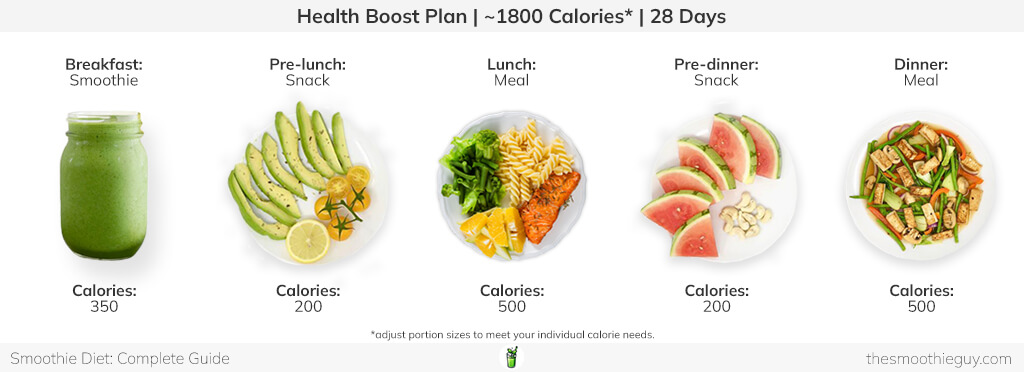
In this plan, focusing on the nutritional value of your meals is more important than counting calories. Whole foods are rich in nutrients and naturally help manage your calorie intake, eliminating the need for accurate calorie tracking. Stick to this plan for up to four weeks to notice improvement in your health.
Weight loss plan (1500 calories per day)
This smoothie diet plan targets weight loss by setting a balanced calorie deficit, which is essential for shedding pounds.
Replace breakfast and lunch with weight loss smoothies, and have a light meal rich in protein and low in fat for dinner. You can also have two healthy snacks between meals to control hunger and sustain energy.
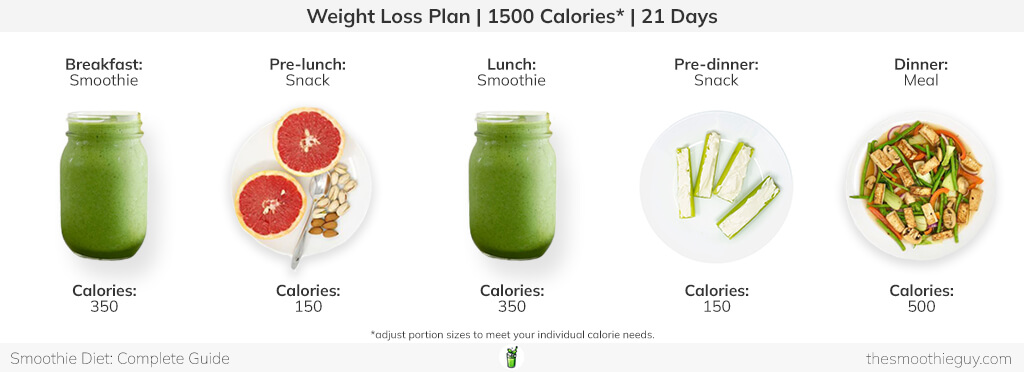
By following this plan consistently for three weeks, you can effectively manage your calorie intake and boost weight loss.
Detox plan (1200 calories per day)
This smoothie diet plan aims to help the liver and kidneys to eliminate toxins from your body. You have to replace all regular meals with smoothies. That way, it supplies your body with only the best food without adding more toxins. What is more, it greatly reduces calorie intake. That enables the body to use its energy reserves, which helps to lose weight. In addition to smoothies, you can have two healthy snacks to ensure a balanced essential nutrient intake.
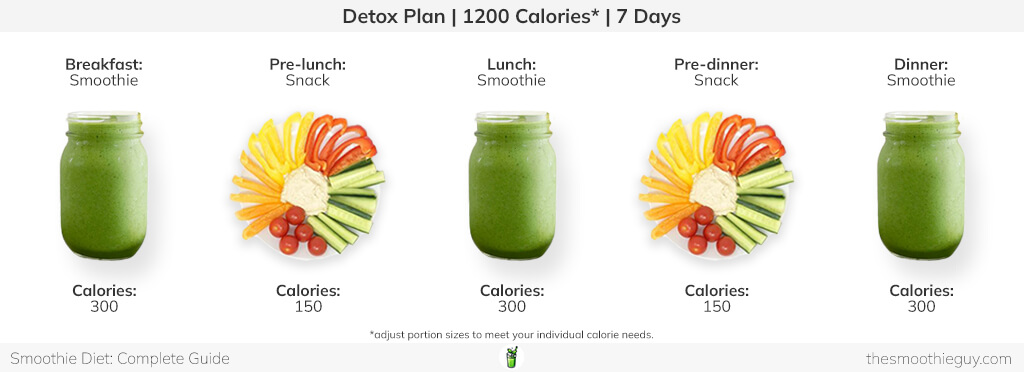
Having smoothies that are high in fiber is important in this plan. Increased fiber intake can improve bowel movements, which is necessary for eliminating waste and toxins, thus contributing to the cleansing process. Keep in mind that this plan is for the short term. Follow it for seven days to improve the efficiency of your body's natural detoxification process.
Creating Balanced Smoothies On A Smoothie Diet
Have you decided which smoothie diet plan you want to try? If so, here's a quick warning. Please don't try random smoothie recipes you see on social media, and start replacing your meals with them. I mean the ones that claim to help you lose 5 lbs overnight. I know it might be tempting, but hear me out.
Most of the time, those smoothies aren't balanced enough to be used as meal replacements. They may be overloaded with fruits, additional sweeteners, or fats and contain too many or too little calories. Smoothies like that usually spike blood sugar levels and then suddenly crash them. That makes you feel hungry soon after, which leads to cravings and potentially weight gain. And you don't want that! Especially if you're trying to lose weight.
Instead, look for smoothie recipes from the sources you trust or create your own. Make sure they are balanced and contain a lot of whole foods. Each smoothie should have about 300-350 calories. This aligns with your smoothie diet plan's calorie goals while providing great nutrition.
Which ingredients make a smoothie balanced?
When searching for a smoothie recipe, make sure it includes a variety of ingredients. A well-balanced smoothie should contain leafy greens, fruits, protein, and healthy fats, which makes it a perfect addition to your smoothie diet plan.
Below is a list of ingredients for the smoothie diet, summarizing what to include for balance and what to avoid.
Leafy Greens
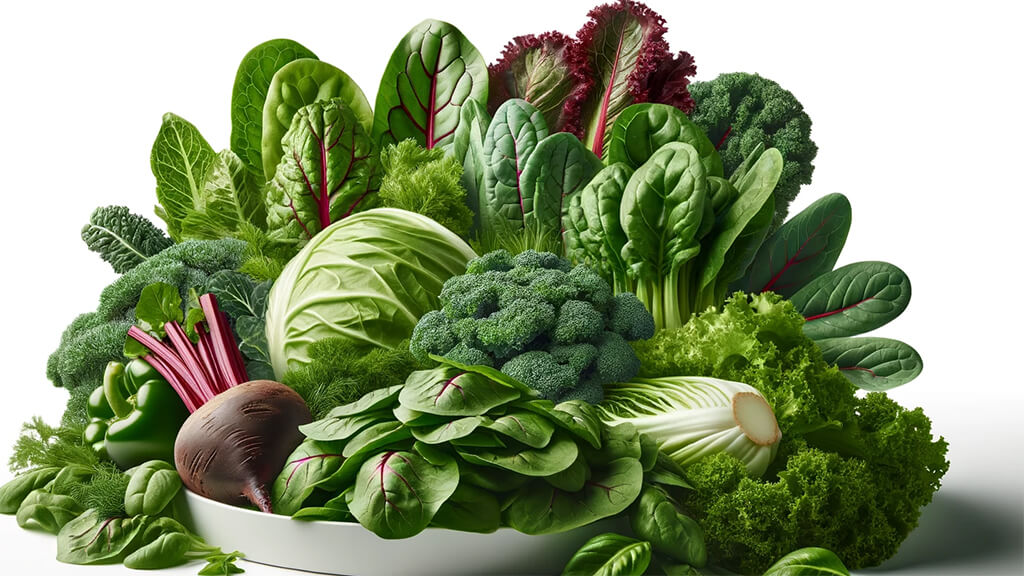
Leafy greens like spinach, kale, collard greens, bok choy, dandelion greens, beet greens, and romaine lettuce are popular choices for smoothies due to their high nutritional value and low-calorie content. Incorporating greens into your smoothies can provide a variety of essential nutrients.
- Vitamins and Minerals: Greens are rich in vitamins A, C, and K, as well as minerals like iron and calcium. These nutrients support various bodily functions, including immune health, bone strength, and blood clotting.
- Antioxidants: Greens contain antioxidants that help combat oxidative stress and may reduce the risk of chronic diseases.
- Fiber: These vegetables are a good source of dietary fiber, which aids in digestion and helps maintain a healthy gut.
- Low in Calories: Greens add volume and nutrients to your smoothie without significantly increasing the calorie content.
For a balanced smoothie, it's recommended that greens make up about 30% of the blender's contents. This ensures you're getting a substantial amount of these nutrients without overpowering the smoothie's taste with the greens' flavor.
Fruits
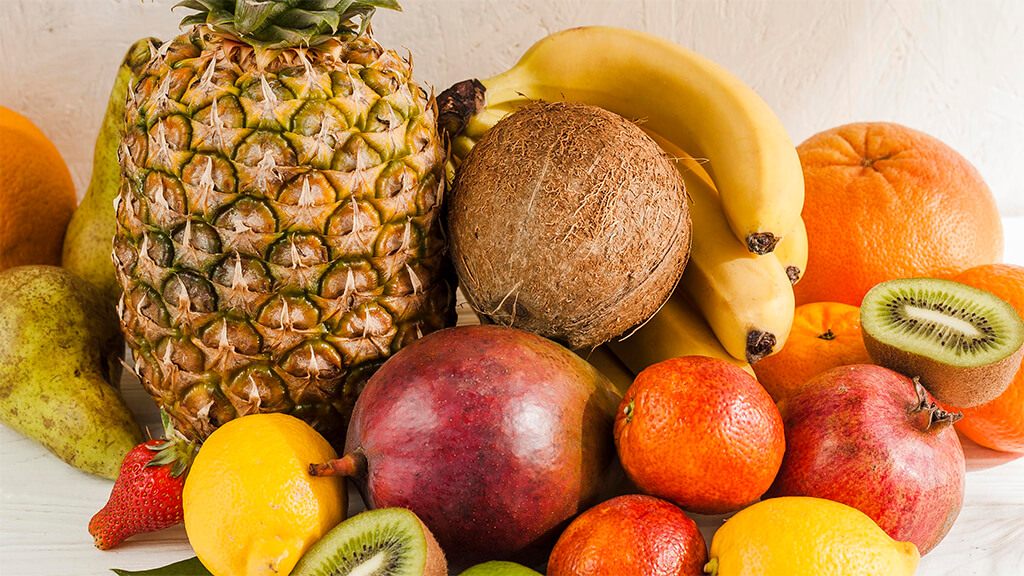
Fruits are a key component in smoothies, they neutralize the bitterness of greens and add natural sweetness. On top of that:
- Vitamins and Minerals: Fruits are rich in essential vitamins such as vitamin C, which boosts the immune system, and vitamin K, important for blood clotting. They also provide a variety of minerals like potassium, which is crucial for heart health and muscle function.
- Antioxidants: Berries, in particular, are high in antioxidants, which help protect the body from oxidative stress and may reduce the risk of chronic diseases.
- Fiber: Fruits are high in dietary fiber, which aids in digestion and can help regulate blood sugar levels.
- Natural Sugars: Fruits contain natural sugars, providing a healthy energy source and making smoothies delicious.
Common fruits used in smoothies include bananas, mangoes, pineapple, kiwis, apples, pears, and berries.
For a balanced smoothie, it's advisable to have fruits make up about 30% of the blender's content. This proportion ensures that the smoothie is not overly sweet while still reaping the nutritional benefits of the fruits.
Proteins
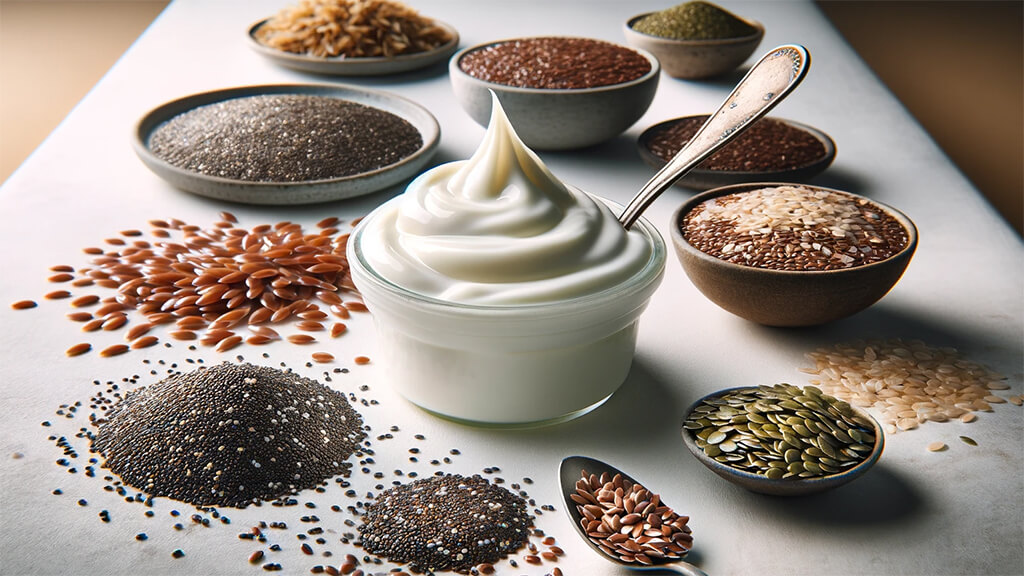
Including protein in your smoothies is important for a balanced nutritional profile. Protein can be added through Greek yogurt, seeds, or nuts. Each of these ingredients not only contributes to the protein content but also brings other nutritional benefits.
- Muscle Maintenance and Growth: Protein is essential for building and repairing muscle tissue, making it particularly important for those who are physically active.
- Satiety and Weight Management: Protein-rich foods can help you feel full longer, aiding in hunger management and potentially assisting with weight control.
- Additional Nutrients:
- Greek Yogurt: This is a good source of calcium, essential for bone health, and probiotics, which are beneficial for gut health.
- Seeds (like chia, flaxseeds, and hemp hearts): These are high in omega-3 fatty acids, which are important for heart and skin health, and fiber, which aids digestion.
- Nuts: Nuts provide healthy fats, fiber, and a variety of vitamins and minerals, including vitamin E and magnesium.
For a balanced smoothie, protein should constitute about 10% of the blender's content. This amount ensures that you are getting a sufficient quantity of protein without overwhelming the other flavors and ingredients in the smoothie. Including protein not only boosts the nutritional value but also contributes to the texture and consistency of the smoothie.
Healthy fats
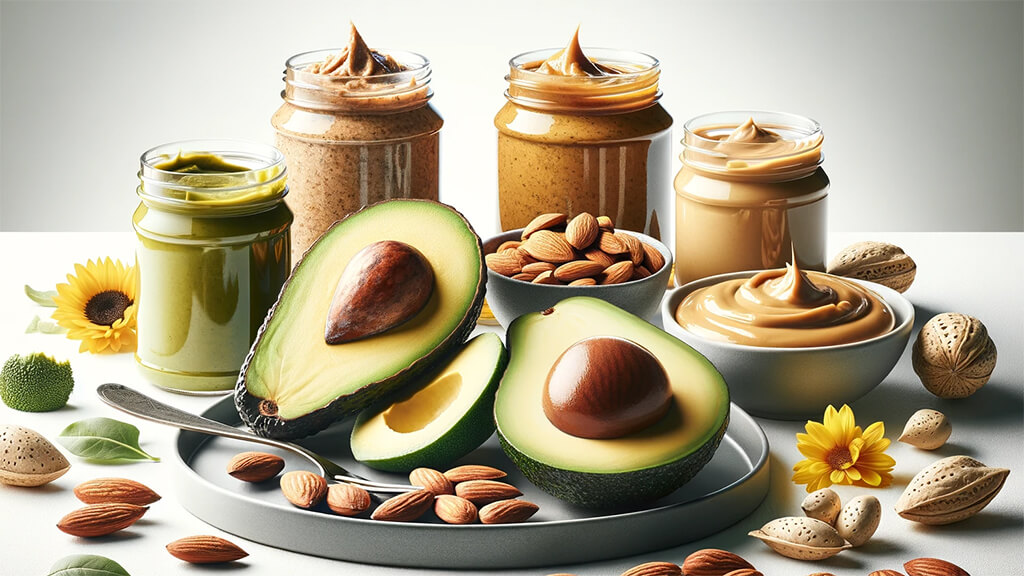
Including healthy fats in your smoothies is beneficial for both nutrition and satiety. Avocado or a teaspoon of nut butter are excellent for adding these beneficial fats. Healthy fats offer several key advantages:
- Sustained Energy: Fats are a concentrated source of energy. Including them in a smoothie can provide longer-lasting energy compared to carbohydrates alone.
- Absorption of Fat-Soluble Vitamins: Healthy fats aid in the absorption of fat-soluble vitamins like A, D, E, and K, which are vital for various bodily functions.
- Heart Health: Monounsaturated and polyunsaturated fats, such as those found in avocados and nuts, can support heart health by improving cholesterol levels and reducing inflammation.
- Brain Health: Fats are essential for brain health, contributing to improved cognitive functions and mood stabilization.
- Hormone Production: Fats play a crucial role in producing hormones, which regulate numerous processes in the body.
In a balanced smoothie, healthy fats should make up about 5% of the blender's content. This proportion ensures you gain the benefits of fats without making the smoothie overly rich or dense.
Liquids
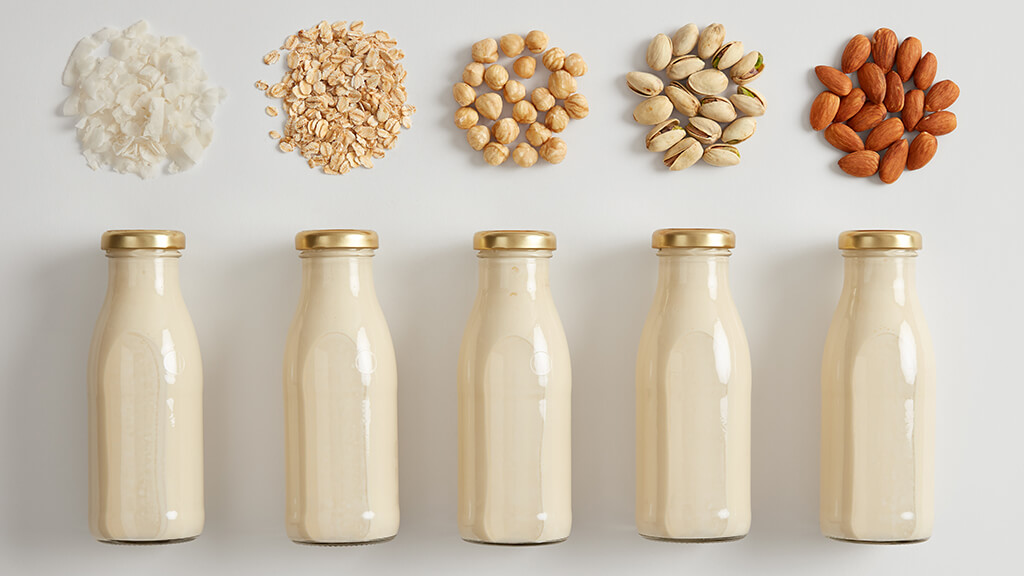
Choosing the right liquid base for your smoothies is important, not just for texture but also for nutritional balance. Low-calorie liquids such as water, coconut water, or unsweetened nut milk are popular. Each of these liquids brings unique benefits:
- Hydration: Keeping hydrated is essential for overall health. Water is the most basic and essential hydrating liquid, but coconut water and nut milks also contribute to hydration.
- Electrolytes: Coconut water is especially beneficial as it is a natural source of electrolytes like potassium, magnesium, and sodium, which are vital for maintaining fluid balance and muscle function.
- Nutrients in Nut Milks: Unsweetened nut milks (such as almond, cashew, or oat milk) can provide additional nutrients. These might include calcium (often fortified in these milks), vitamin E, and healthy fats, depending on the type of nut milk.
- Low Calorie: Using low-calorie liquids helps manage the overall calorie content of the smoothie, making it suitable for those watching their calorie intake.
What about cow's milk? You should avoid it in your smoothies. Not because it's unhealthy but because it adds extra calories. So, if you're on a weight loss or detox plan, make sure to stick with the plant-based alternatives.
Liquids should constitute about 20% of the blender's content in a balanced smoothie. This proportion typically amounts to around 1 cup, which is often the sweet spot for achieving the right consistency without diluting the flavor. This volume can be adjusted based on personal preference and the desired thickness of the smoothie.
Superfoods and boosters
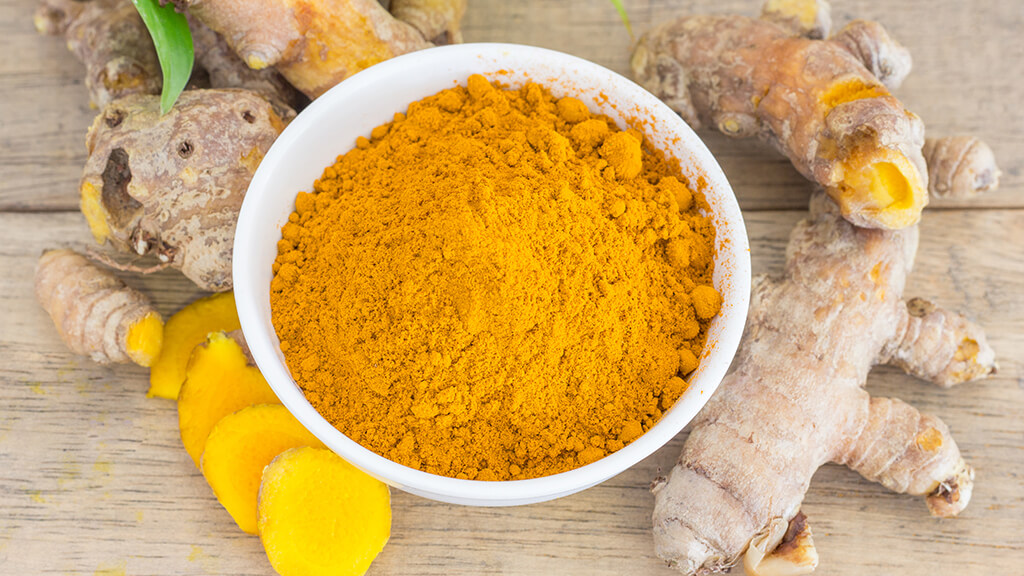
Superfoods and boosters are excellent additions to smoothies, enhancing their nutritional profile significantly. Common superfoods like spirulina, chlorella, turmeric, and ginger each bring unique health benefits:
- Spirulina and Chlorella: These blue-green algae are powerhouses of nutrition. They are rich in protein, vitamins (especially B vitamins), minerals, and antioxidants. They can aid in detoxification and may have anti-inflammatory properties.
- Turmeric: Known for its anti-inflammatory properties due to the active compound curcumin, turmeric can also aid in digestion and has antioxidant benefits.
- Ginger: This root is celebrated for its digestive benefits, ability to soothe nausea, and its anti-inflammatory and antioxidant properties.
In a balanced smoothie, superfoods and boosters should generally constitute about 1-5% of the blender's content. This small percentage is sufficient due to their high concentration of nutrients. They are meant to enhance the nutritional value of the smoothie without overpowering the primary ingredients.
Supplements
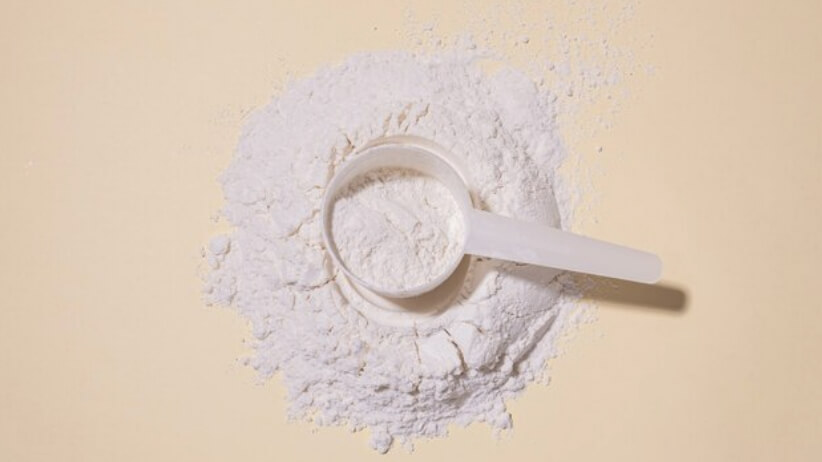
Including supplements such as protein powder or collagen peptides in your smoothies can conveniently enhance their nutritional value. When selecting supplements, it's crucial to choose unflavored, premium quality, and minimally processed options. These criteria usually ensure a product with fewer additives and a more natural profile. However, it's important to be mindful of the caloric content of these supplements; for example, one scoop of collagen peptides can add around 40 extra calories.
While supplements are an optional addition to a balanced smoothie, their use should be moderate. Similar to superfoods, supplements should ideally not exceed 5% of the blender's content to maintain the overall balance and healthfulness of the smoothie.
These ingredients make a smoothie nutritious and well-balanced. But remember, the proportions I listed are not always correct (blender jar size difference, etc.), and for the best balance, it's good to be aware of the calories and nutrients in each ingredient.
Which ingredients to avoid during the smoothie diet?
When following the smoothie diet, minimize or eliminate processed foods not only from your smoothies but also from meals and snacks you have alongside them. Processed foods often contain empty calories, primarily derived from added sugars and unhealthy fats.
Don't use these in your smoothies:
- Flavored Yogurts: Their nutritional profile is usually poorer; they typically have less protein replaced with added sugars. Instead, use all-natural Greek yogurt.
- Canned Fruits: Usually, they contain added syrups and sugars. If you can't get fresh, use quick frozen fruits instead.
- Peanut Butter: Some brands add trans fats and sugar to their peanut butter. Ensure that you use all-natural peanut butter that only contains peanuts and salt.
- Fruit Juices: Store-bought fruit juices are often high in added sugars and lack the fiber found in whole fruits. Instead, opt for freshly squeezed or cold-pressed options. Consider vegetable juices for lower sugar content.
- Instant Oatmeal: These may contain added sugars and artificial flavors. Instead, use rolled oats or steel-cut oats.
- Artificial Sweeteners: While low in calories, artificial sweeteners can still negatively impact your gut health and may lead to cravings. To make your smoothie sweeter, use natural sweeteners, such as stevia.
Limit these foods in your other meals:
- Processed Meats: Sausages, hot dogs, deli meats, bacon, and ham are often high in sodium and preservatives like nitrates. Choose lean, unprocessed meats or plant-based proteins as healthier alternatives.
- White Flour Products: Like white rice and pasta, white flour products like pastries, white bread, and some crackers are stripped of nutrients and fiber during processing.
- Energy Bars: Some are heavily processed and high in sugar and artificial ingredients. Check for bars with minimal and whole ingredients.
- Boxed Cereals: Many are high in added sugars and low in fiber. Choose whole-grain, low-sugar options.
- Highly Processed Snacks: Chips, cookies, and most packaged snacks are typically high in unhealthy fats, sugars, and sodium.
There are many more foods that you should avoid that are not listed here. When you're grocery shopping, please read the labels. If you find products with ingredient lists that start with sugar or salt, or if the ingredients list covers the entire package, it's a good idea to avoid them and look for less processed alternatives. This advice applies to everyone, whether you're following the smoothie diet or not.
Making a perfect smoothie
It's smoothie time! What's great about the smoothie diet is that making a meal-replacement smoothie usually takes less than 5 minutes. That's convenient if we compare it to cooking regular meals.
What is more, making smoothies at home usually costs around $2 per serving. It's not that much, considering it's a meal replacement. The cost can increase if you opt for organic produce, exotic fruits, or premium supplements, though. But here's a quick tip: use seasonal fruits and vegetables to reduce costs. They are often more affordable and just as nutritious. Also, make sure to wash your ingredients properly, whether they are organic or not, as they are still sprayed with chemicals.
Now that you learned which ingredients should go in a balanced smoothie, let me walk you through making one. By following the tips below, you will enjoy the perfect smoothie every time.
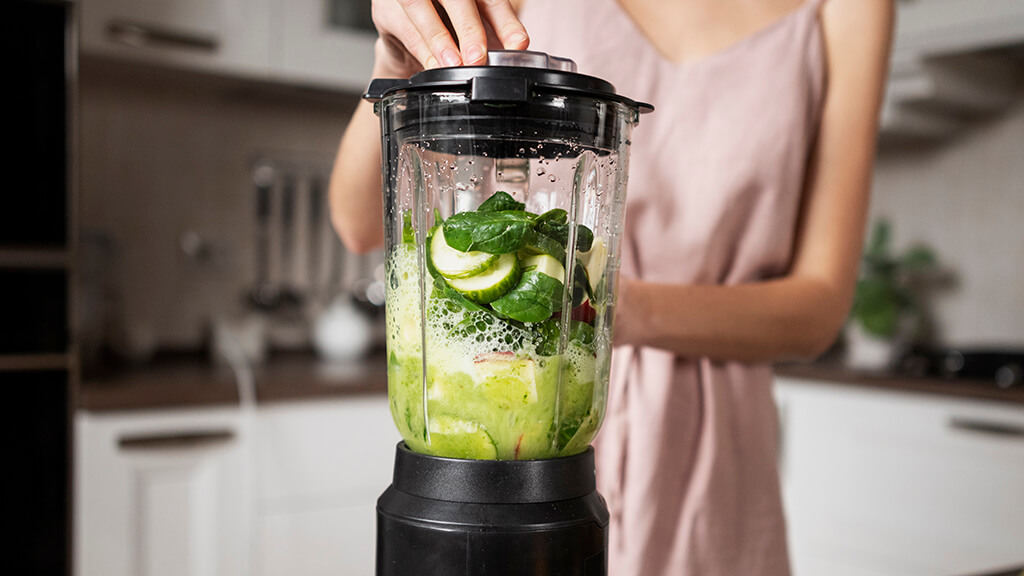
Get a blender
First, you need a blender. Fortunately, almost any blender you could buy today makes great smoothies. However, one blender can make it better than the other. If you don't have a blender or looking for a replacement, I have a guide on picking the best blender for smoothies, featuring my top picks for all budgets.
Alternatively, you can also use a food processor or an immersion blender for making smoothies. The texture may be slightly different, though.
How-to
- Add liquids first: Beginning with liquids helps to create a vortex that will draw the solid ingredients down toward the blades. It prevents chunky pieces and ensures a smoother texture.
- Add fruits and veggies: These are added after the liquid. They provide thickness to the smoothie.
- Protein next: It contributes to the creaminess of the texture.
- It's healthy fats turn: just like protein, healthy fats contribute to the creamy texture.
- Superfoods and supplements in the end: They're added last to ensure they're evenly distributed throughout the smoothie without getting stuck to the bottom.
- Let's blend: If your blender has a pulse feature, use it. It helps to distribute the ingredients evenly before blending. If not, start with low speed and let it run for 10 seconds, then increase the speed to high and let it run for up to 60 seconds. Avoid over-blending to prevent the smoothie from becoming too thin or warm.
- That's it! You can now enjoy your well-blended smoothie. If you want to drink it later, place it in a tightly sealed container in the refrigerator. Try to consume it within 24 hours for the best quality and to ensure the nutrients are still potent.
PRO TIP: Clean your blender jar immediately after each use. A quick cleaning hack is to blend lukewarm water with a drop of dish soap, which helps prevent stubborn food residue and odors.
Smoothie Diet Recipes For Every Health Goal
If you're not yet comfortable creating your own meal-replacement smoothies, here are some recipes you could try. All are well-balanced and contain about 300-350 calories, which makes them suitable for whichever smoothie diet plan you chose earlier.
Weight loss
These smoothies are typically lower in calories but high in fiber and protein to help keep you full. They often incorporate ingredients that may boost metabolism and reduce hunger pangs.
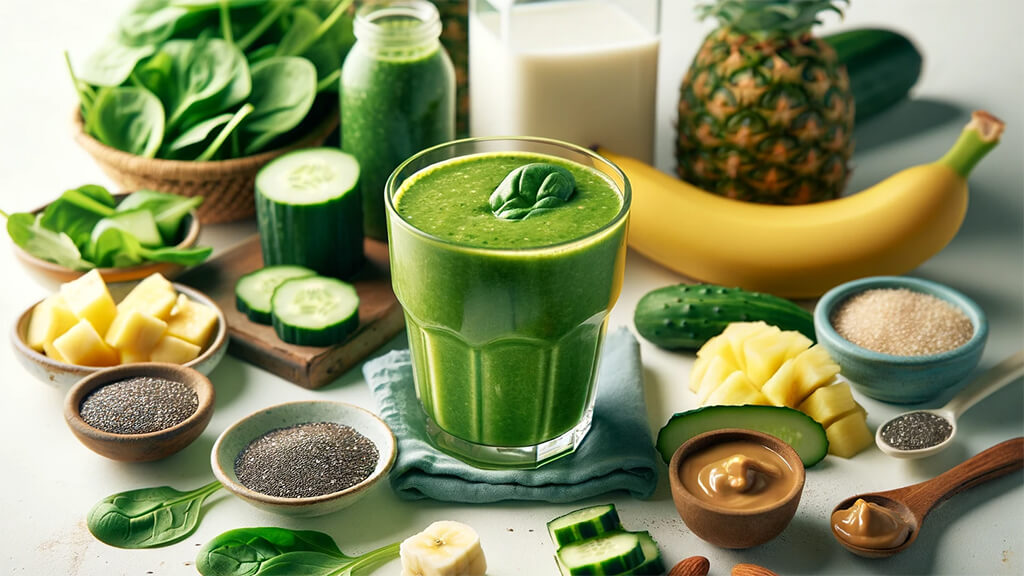
Ideal for weight loss, high in fiber and protein, and aids in feeling full longer.
Ingredients: Spinach, cucumber, pineapple, banana, almond milk, chia seeds, peanut butter.
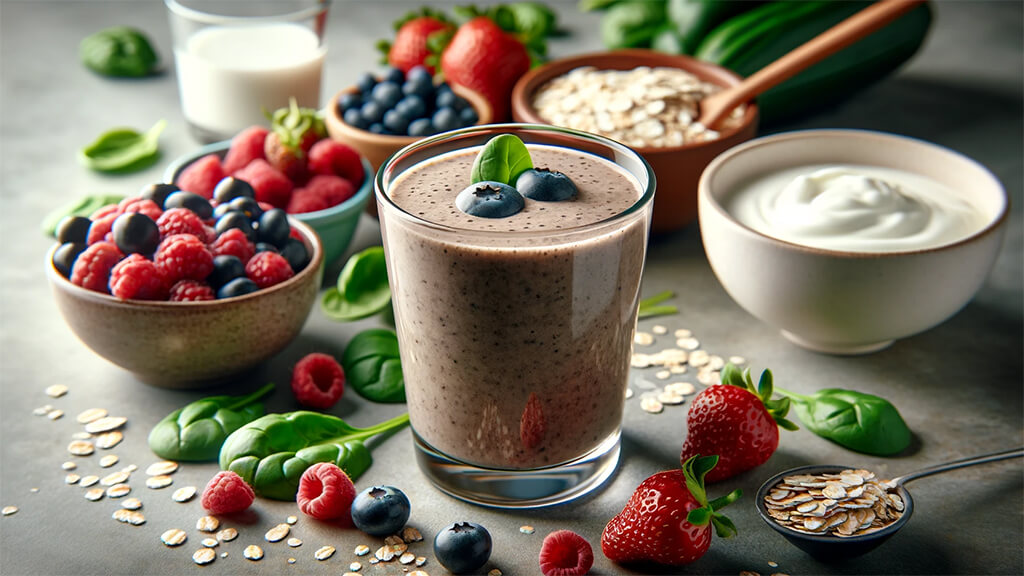
Triple Berry Oat Tropical Smoothie
Antioxidant-rich, promotes satiety, and aids in weight management.
Ingredients: Mixed berries, Greek yogurt, spinach, oats, almond milk.
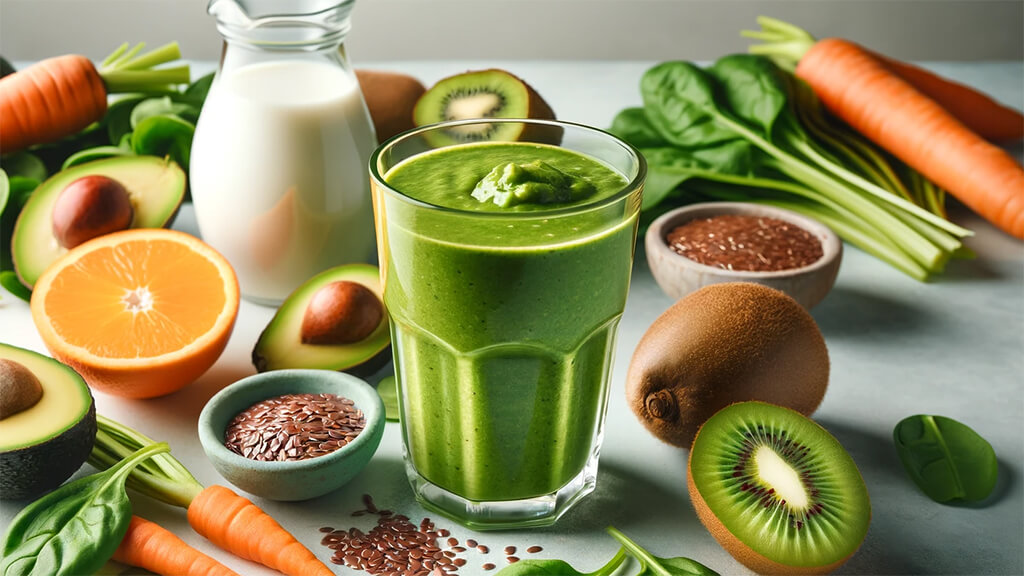
Nutrient-dense, supports weight loss goals, and enhances fiber intake.
Ingredients: Orange, carrot, kiwi, avocado, spinach, flaxseed, almond milk.
Detox
Detox smoothies usually contain ingredients that support the body's natural detoxification processes, such as leafy greens and high-antioxidant fruits. They focus on simplicity and nutrient-rich ingredients for bodily cleansing.
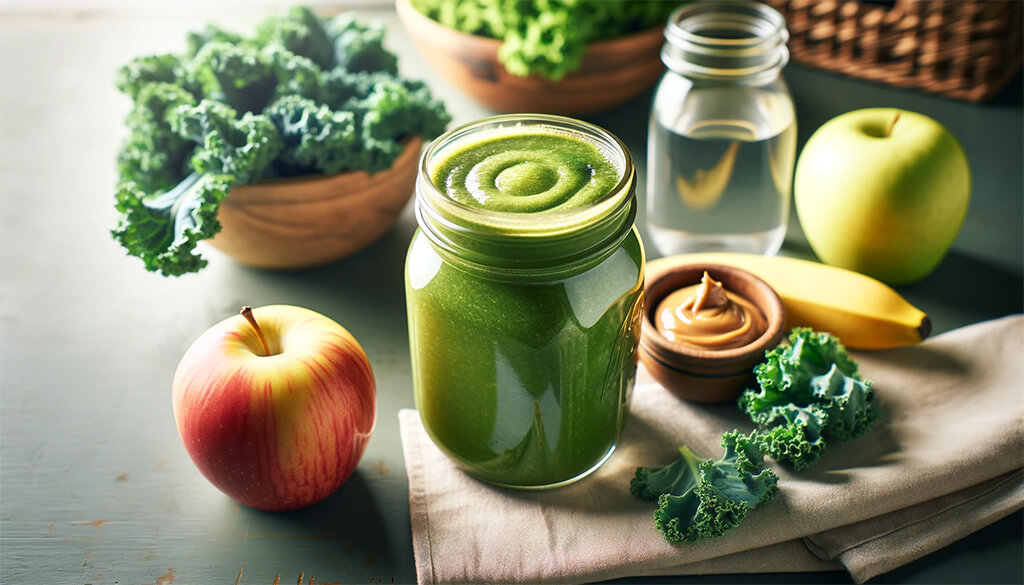
A detoxifying blend that supports digestion and provides natural energy.
Ingredients: Apple, banana, kale, almond butter, water.
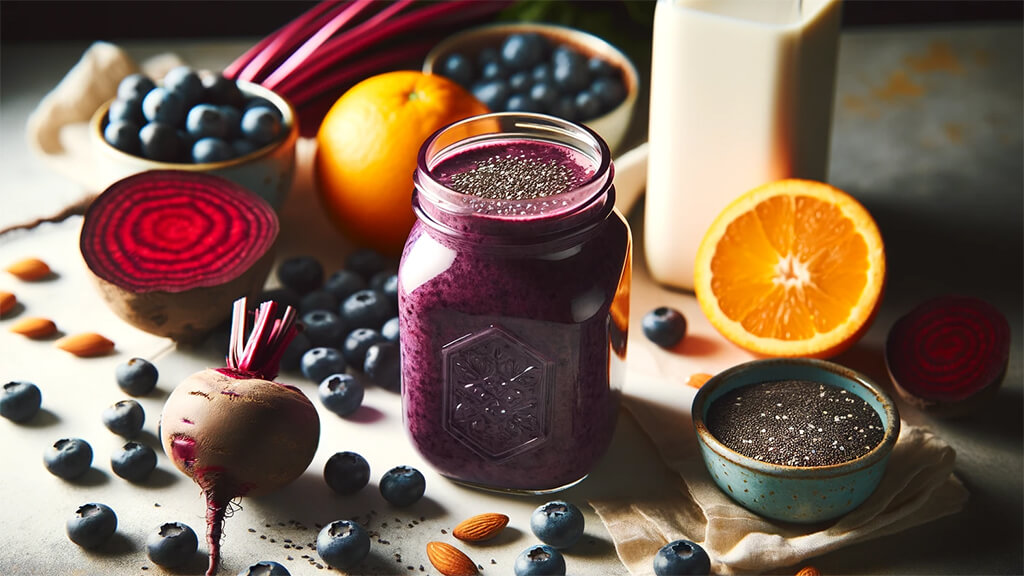
Rich in antioxidants, supports body detox, and boosts overall health.
Ingredients: Blueberries, beets, orange, chia seeds, flaxseeds, almond milk.
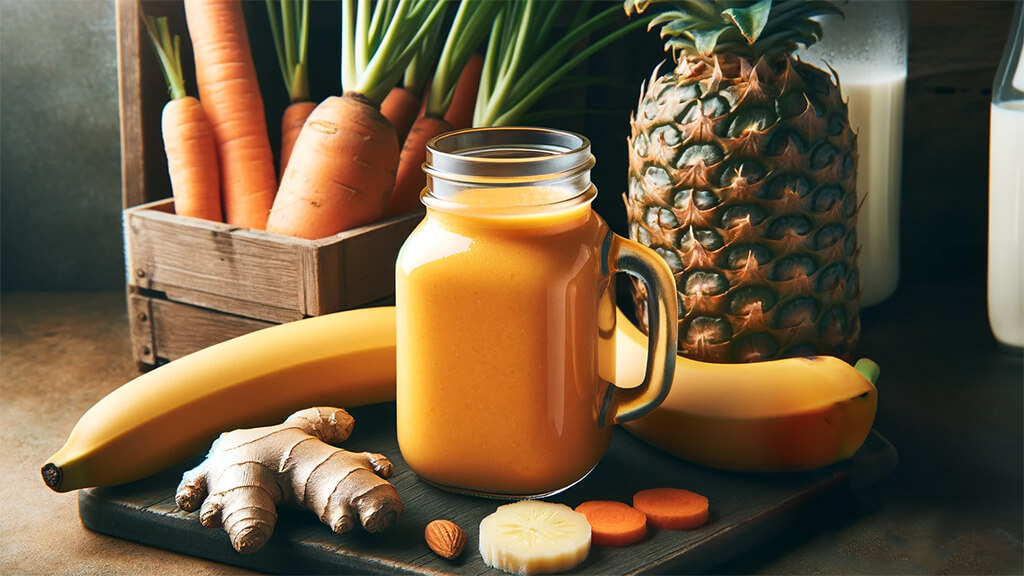
Aids in detoxification, immune health support, with a refreshing taste.
Ingredients: Carrots, pineapple, banana, ginger, chia seeds, avocado, almond milk.
Immune system
Immunity-boosting smoothies are packed with vitamins, minerals, and antioxidants. Ingredients like citrus fruits, ginger, and turmeric are common, as they're known for their potential to support the immune system.
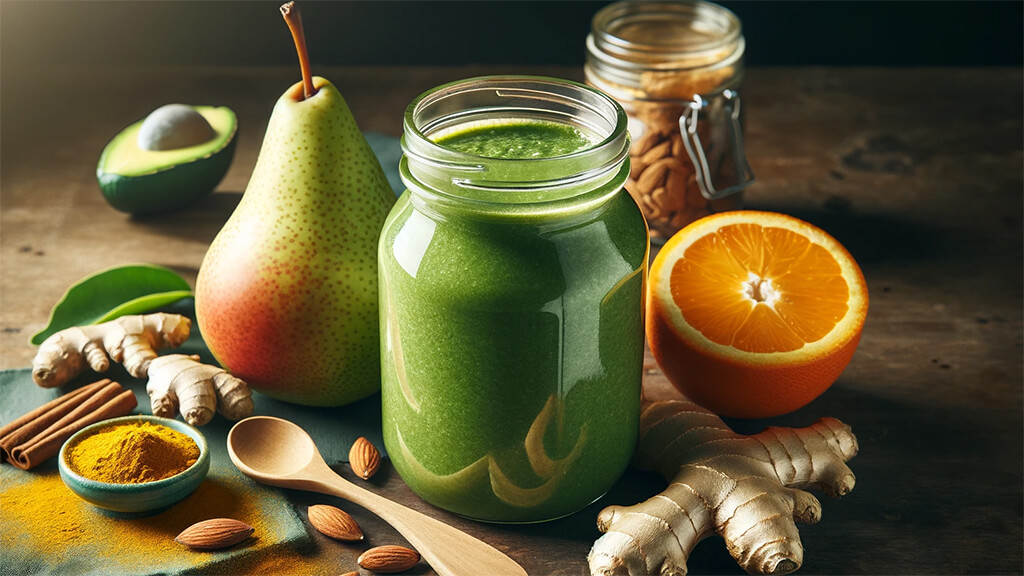
Boosts the immune system, revitalizing with a tangy flavor.
Ingredients: Orange, avocado, pear, ginger, turmeric, almond butter, honey, water.
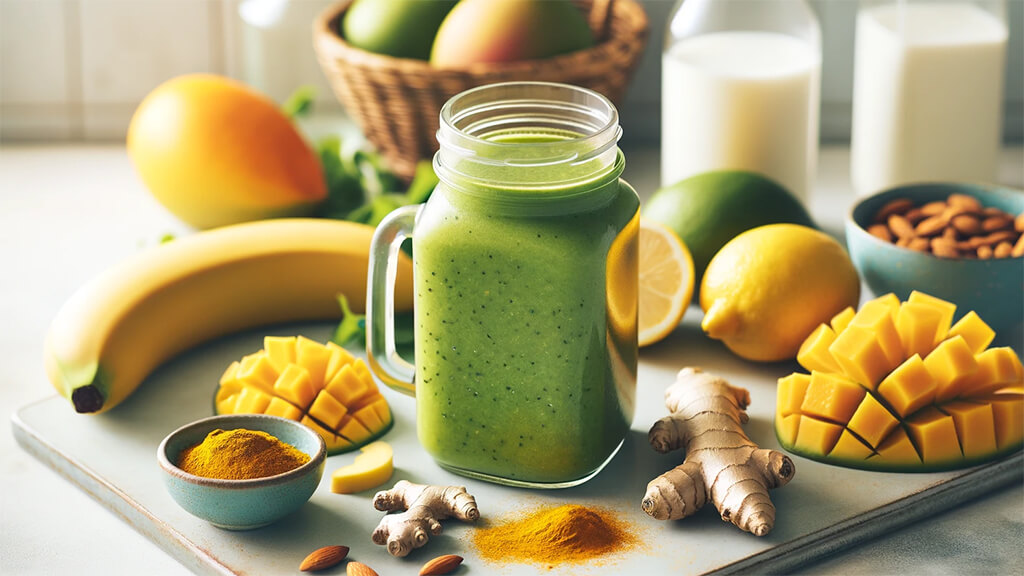
Soothing, immune-strengthening, and anti-inflammatory.
Ingredients: Mango, banana, turmeric, ginger, almond butter, lemon juice, spinach, almond milk.
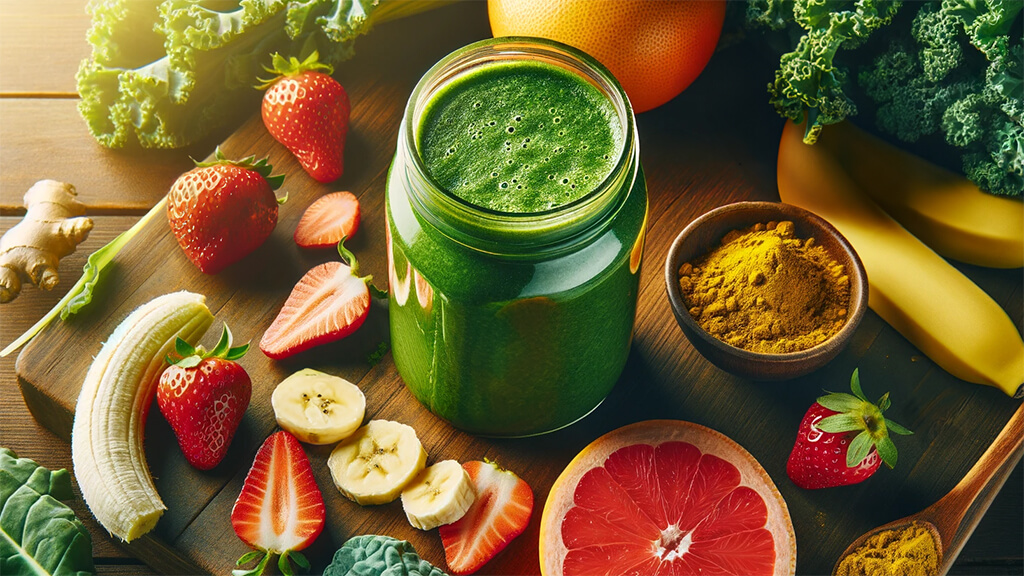
High in Vitamin C for immune support, with a spicy twist.
Ingredients: Grapefruit, strawberries, banana, ginger, turmeric, flaxseed, Greek yogurt, kale, honey, water.
Gut health
These smoothies are designed to support digestive health and often include ingredients that are high in fiber and probiotics. They aim to promote a healthy gut microbiome and can aid in digestion.
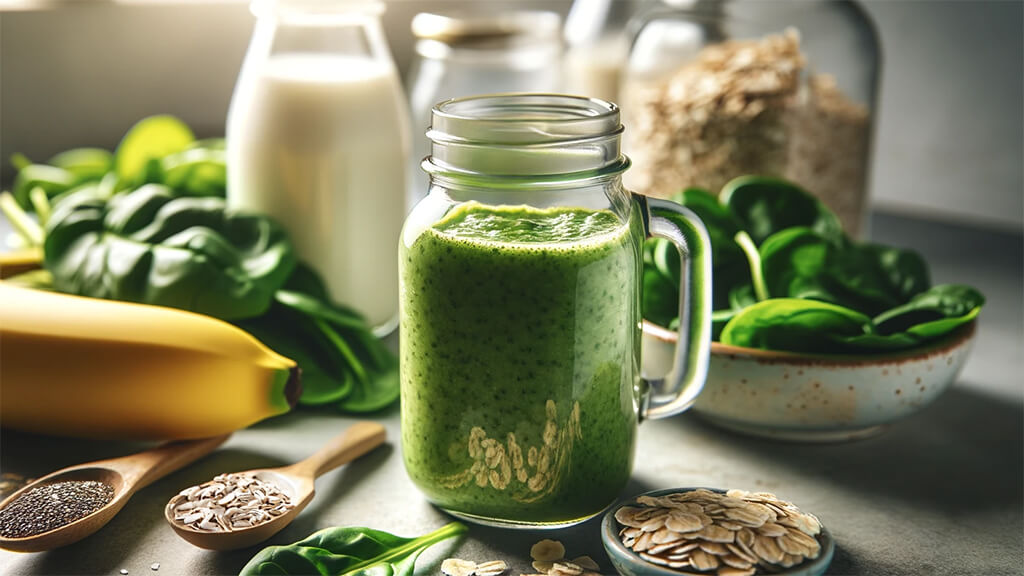
Supports digestive health with probiotics and fiber.
Ingredients: Banana, oats, kefir, chia seeds, cinnamon, spinach.
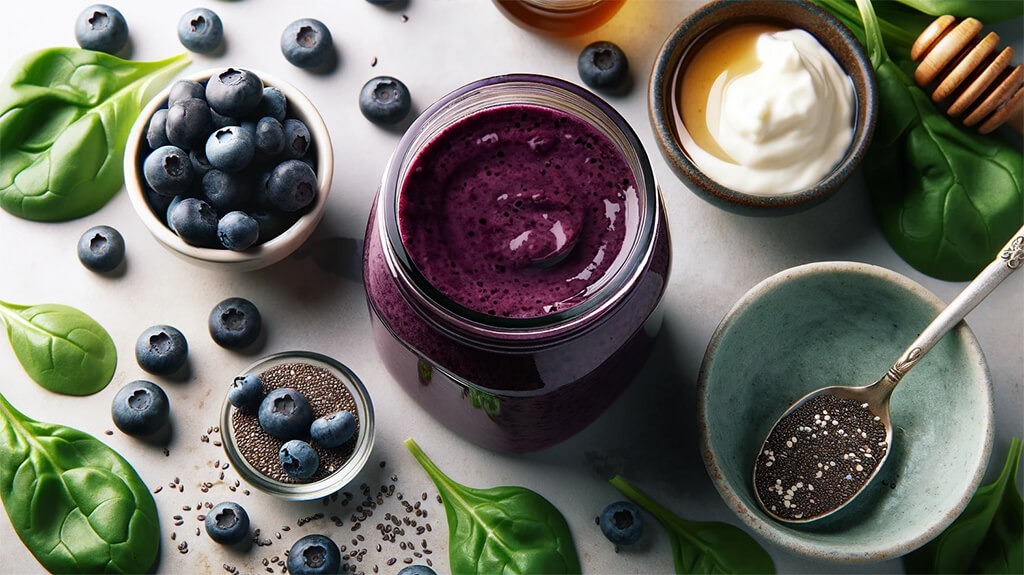
High in fiber, promotes gut health and digestion.
Ingredients: Blueberries, Greek yogurt, flaxseeds, chia seeds, spinach, honey, almond milk.
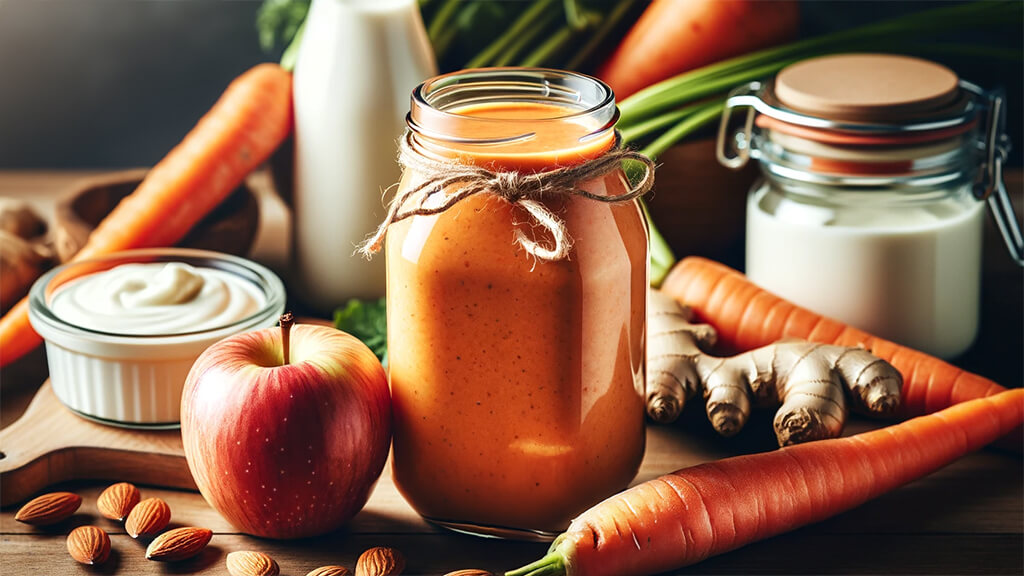
Aids in digestive health, soothing for the stomach.
Ingredients: Apple, ginger, carrot, hemp seeds, Greek yogurt, almond butter, water.
Glowing skin
Skin-healthy smoothies are full of vitamins and minerals essential for skin health, such as vitamin C and E. They often include ingredients like berries, nuts, and seeds that may help to protect the skin and promote a natural glow.
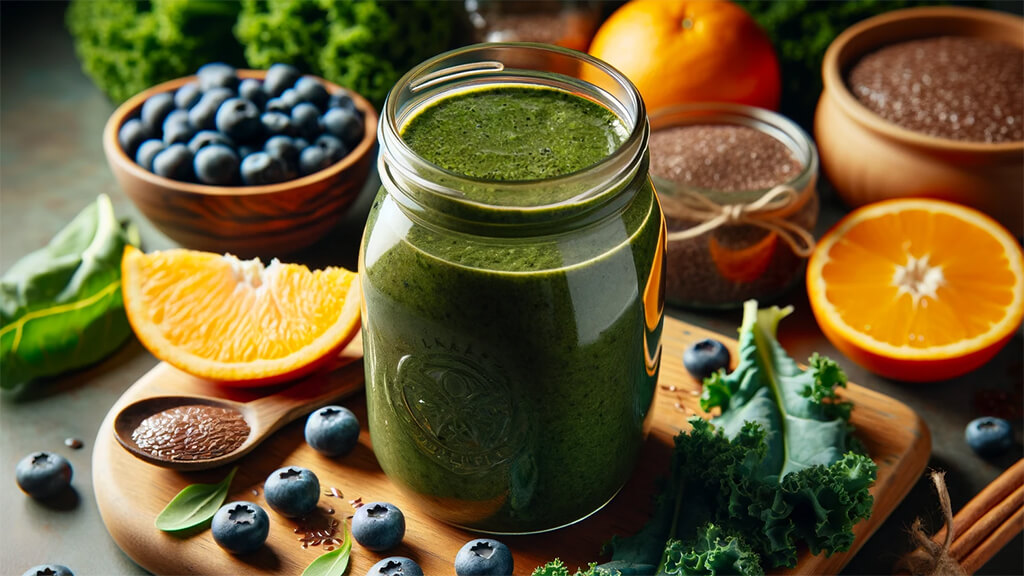
Vitamin-rich for skin health, promoting a natural glow.
Ingredients: Blueberries, orange, flaxseeds, pumpkin seeds, kale, almond milk, cinnamon.
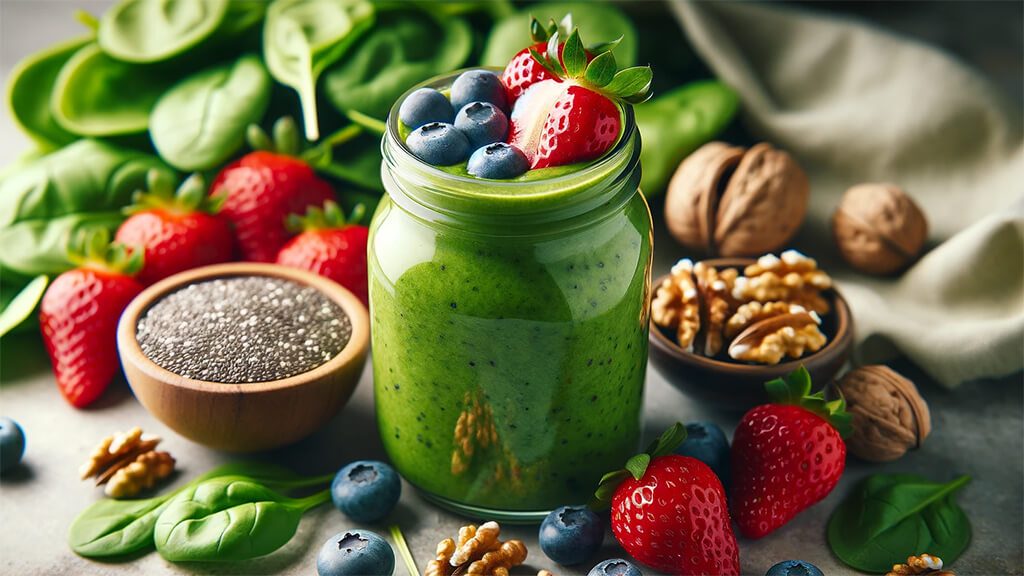
Nutrient-rich, supports skin health and provides a natural glow.
Ingredients: Strawberries, blueberries, walnuts, hemp hearts, spinach, coconut milk.
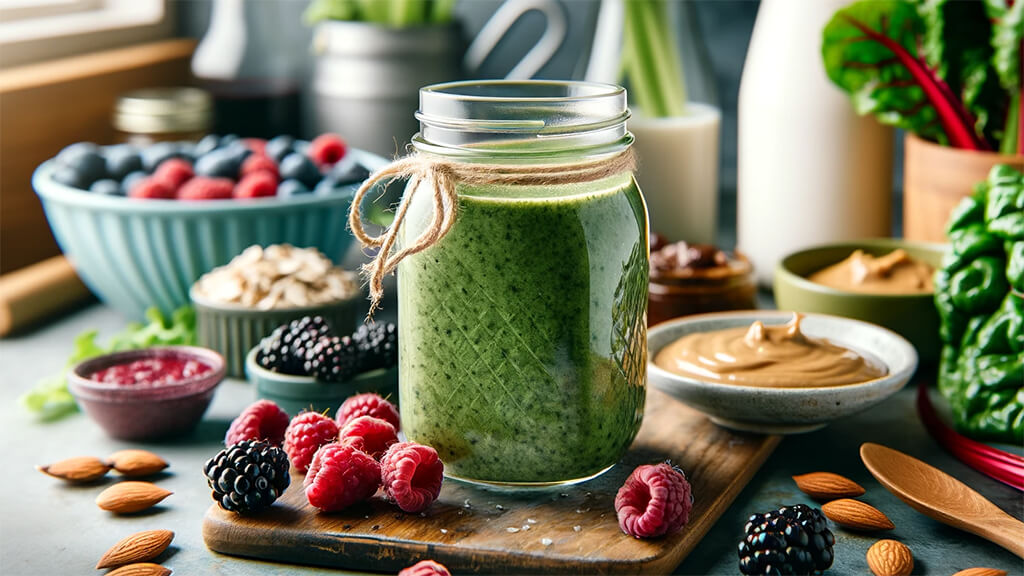
Vitamin and mineral-rich, enhances skin health and adds a natural glow.
Ingredients: Raspberries, blackberries, sunflower seeds, flaxseeds, almond butter, swiss chards, oat milk.
Energy
Energy-boosting smoothies provide sustained energy through a combination of complex carbohydrates, healthy fats, and proteins. They often avoid added sugars and may include oats, nuts, and seeds for long-lasting energy.
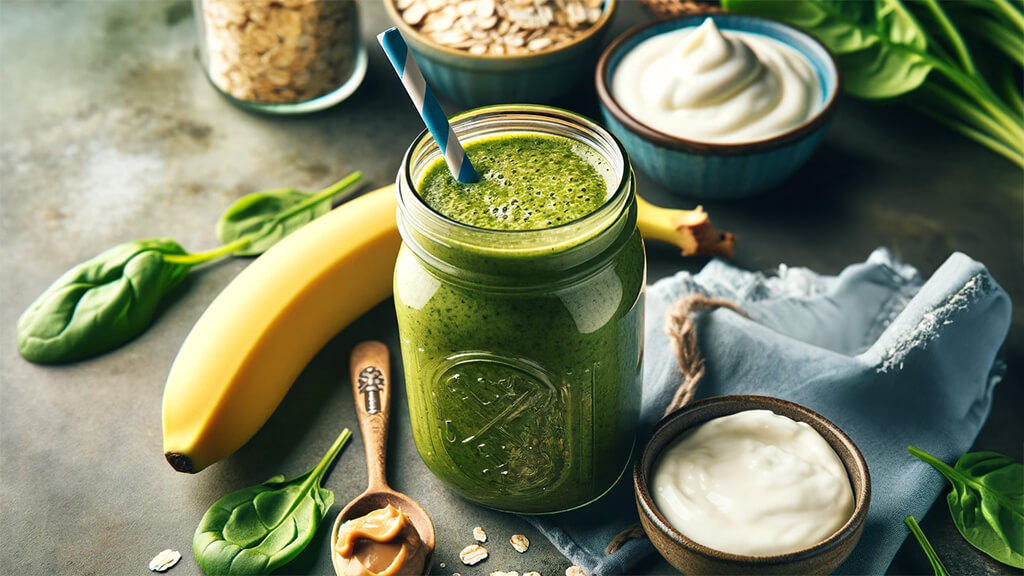
Energizing, perfect for sustained energy throughout the morning.
Ingredients: Banana, oats, Greek yogurt, almond butter, flaxseed, spinach, almond milk.
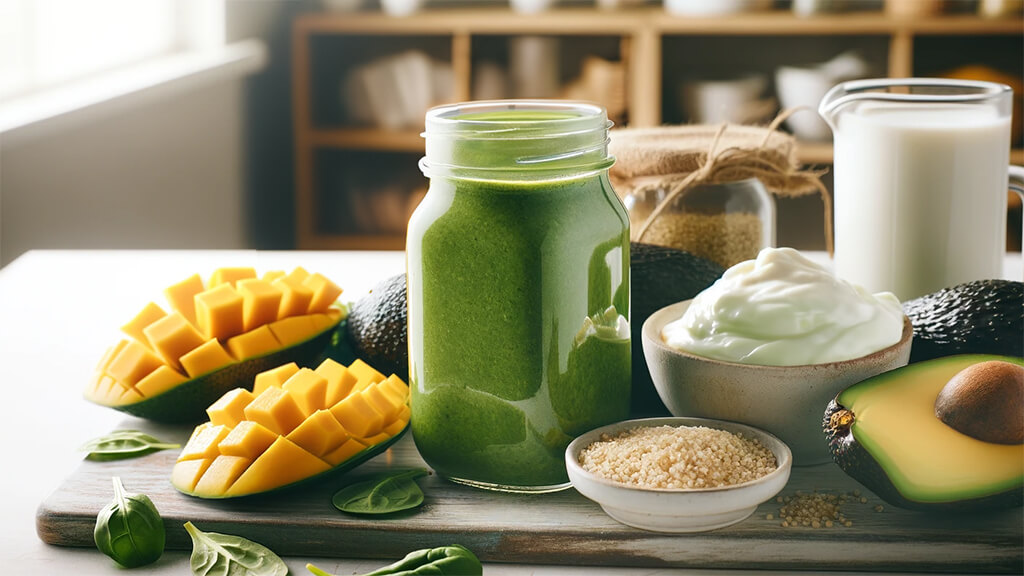
Packed with protein, ideal for energy and muscle health.
Ingredients: Avocado, mango, quinoa, chia seeds, spinach, almond milk.
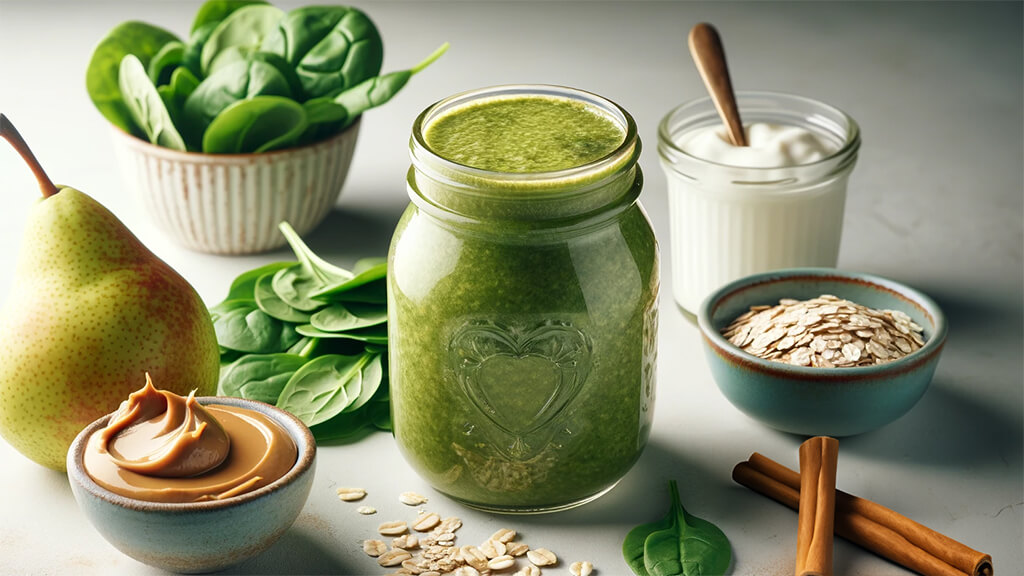
Energizing and satisfying, great for fitness enthusiasts.
Ingredients: Pear, peanut butter, Greek yogurt, oats, spinach, cinnamon, water.
Solid Foods To Complement Your Smoothie Diet
Smoothies are good for losing weight and getting healthy. However, they shouldn't be your only food. You can use them to replace certain meals daily, but you also have to include other healthy meals and snacks alongside them. That is important because smoothies usually contain fewer calories than regular meals, which can make you hungry and tired, and it's not good for your body in the long run. By eating solid foods as well, you'll get enough energy and nutrients, which makes it easier to stick to this diet and see the results.
Healthy meals
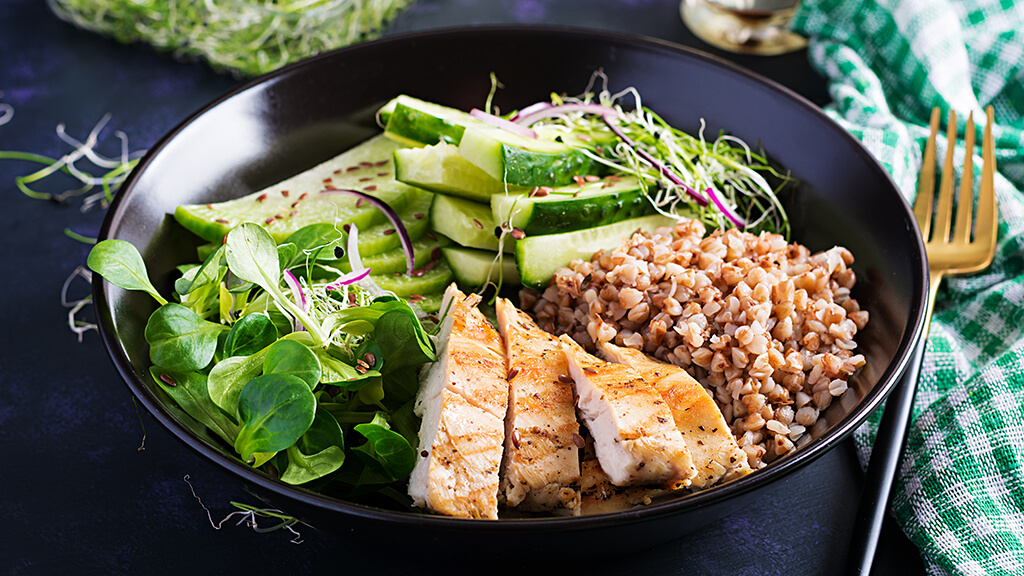
When incorporating solid foods into your smoothie diet, it's essential to focus on healthy meals that are low in fat, high in protein, and rich in whole foods, ideally containing around 450-500 calories each. Such meals offer a balanced mix of protein, healthy fats, and carbohydrates, filled with nutrients to keep you satisfied and energized throughout the day.
Here are some suggestions for complete, balanced meals that go well with the smoothie diet:
Meal suggestions:
- Grilled Chicken and Quinoa Salad: Grill a lean chicken breast and serve it over a bed of quinoa mixed with a variety of fresh vegetables like bell peppers, cucumbers, and cherry tomatoes. Dress it lightly with olive oil and lemon juice.
- Vegetable Stir-Fry with Tofu: Stir-fry a mix of colorful vegetables such as broccoli, carrots, and bell peppers with tofu in a light soy sauce. Serve this over brown rice or whole grain noodles.
- Baked Salmon with Sweet Potato: Bake a salmon fillet seasoned with herbs and serve it with a side of baked sweet potato and steamed green beans or asparagus.
- Turkey and Vegetable Whole Wheat Wrap: Use a whole wheat tortilla to wrap lean turkey slices, mixed greens, avocado, and a variety of veggies like grated carrots and cucumbers. Add a light yogurt-based dressing for flavor.
- Lentil Soup with Whole Grain Bread: A bowl of homemade lentil soup, rich in protein and fiber, can be very filling. Pair it with a slice of whole grain bread for a complete meal.
- Egg and Vegetable Frittata: A frittata made with eggs, spinach, tomatoes, onions, and a bit of feta cheese, served with a side salad.
- Chickpea and Quinoa Buddha Bowl: Combine cooked quinoa, chickpeas, avocado, mixed greens, and a variety of veggies. Add a tahini-lemon dressing for a flavorful touch.
Healthy snacks
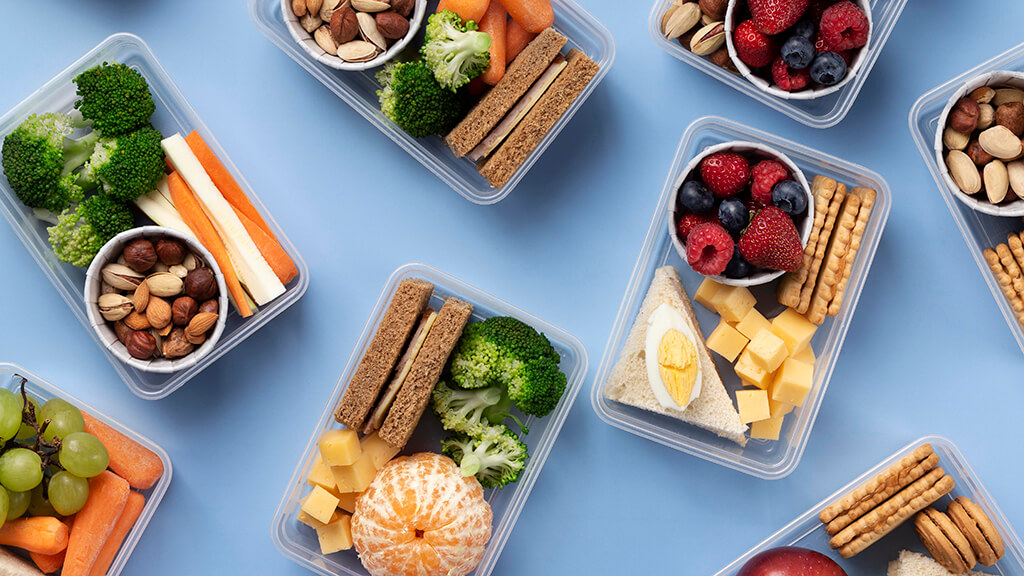
During the smoothie diet, it's crucial to include healthy snacks, too. They provide energy and essential nutrients but are low in calories. They're not just nutritious but also help keep you full and prevent overeating at meal times.
Below are some great snack options, each around 150 calories or less.
Snack suggestions:
- Greek Yogurt with Berries: A small bowl of Greek yogurt topped with a handful of fresh berries. This snack is rich in protein and antioxidants.
- Carrot and Cucumber Sticks with Hummus: Crunchy carrot and cucumber sticks paired with a small serving of hummus for a satisfying, fiber-rich snack.
- Apple Slices with Peanut Butter: Slice an apple and pair it with a tablespoon of peanut butter for a blend of sweet and savory flavors, along with a good balance of fiber and protein.
- Boiled Egg: A hard-boiled egg is a great protein-rich snack that's easy to prepare in advance.
- Air-Popped Popcorn: A cup of air-popped popcorn is low in calories and high in fiber, making it a satisfying, light snack.
- Rice Cake with Avocado: Top a rice cake with a thin slice of avocado for a snack rich in healthy fats and fiber.
- Cherry Tomatoes with Mozzarella: A few cherry tomatoes paired with a small piece of mozzarella cheese, seasoned with a bit of basil and balsamic vinegar.
- Dark Chocolate and Almonds: A small piece of dark chocolate with a few almonds can satisfy sweet cravings while providing antioxidants and healthy fats.
Following the smoothie diet this way helps you stick with it for the long haul. It's about enjoying those tasty smoothie creations and also having a variety of other healthy foods to keep you going strong.
Tips For Better Results With Smoothie Diet
Here are some additional tips that can help to improve your results with the smoothie diet:
- Rotate Smoothies: Don't stick to one or two smoothie recipes; try others. This will prevent boredom and ensure you get a range of nutrients.
- Chew Your Smoothies: Even though smoothies are a liquid, try to “chew” them before swallowing. This can aid digestion and help trigger the feeling of fullness, giving your body the time to recognize satiety signals.
- Drink Water: While smoothies have lots of water from fruits and veggies, remember to drink plain water throughout the day. It not only helps to stay hydrated but also your stomach full, which can reduce food cravings. That's great when you're trying to lose weight. Make sure to drink at least 2 liters of water daily.
- Exercise: Exercise is an excellent complement to the smoothie diet, enhancing weight loss and health benefits. Aim for 30 minutes of cardio—such as walking or cycling—most days of the week. Add strength training a few times weekly to boost metabolism and support muscle growth. Include flexibility exercises like yoga to maintain balance and reduce stress. Consistency is key, so choose activities you enjoy and can stick with long term.
- Monitor and Adjust: Regularly monitor your weight and adjust caloric intake accordingly. If you feel sluggish or hungry on the diet, you might need to consume more calories, while if you're not losing weight on the weight loss plan, you might need to reduce your intake slightly.
FAQs
A: With the smoothie diet weight loss plan, you may lose up to 2 pounds per week. It is considered a safe and sustainable rate. However, how much weight you lose can change depending on your body's metabolism, how much you exercise, and if you stick to the diet.
A: Yes, you can repeat the smoothie diet plans, but with certain considerations for each. Health Boost Plan is suitable for continuous use. Weight Loss Plan can be repeated, though it's advisable to take breaks between cycles. Detox Plan should be used for short durations and not back-to-back, allowing time for regular eating between cycles to ensure overall health and nutrient intake.
A: Yes, you can have black coffee during the smoothie diet. Avoid adding sugar, milk, or cream, though. If black coffee isn't to your taste, you can opt for green tea. It is a great alternative, offering a lower caffeine content and additional health benefits.
Wrapping Up
I hope this guide has helped you understand what the smoothie diet is and how it works. It's an excellent way to take a break from the refined foods that surround us and to include more whole foods in your diet.
Whether you're looking to lose weight, boost your immunity, detox your body, soothe your digestive system, improve your skin's appearance, or increase your energy levels, incorporating smoothies into your diet correctly can be beneficial! Just make sure to use the right ingredients in them. Your smoothies should not only taste good but also be beneficial for your body.
And remember, the other foods you eat alongside smoothies are equally important in making this diet plan sustainable and effective for long-term success.

